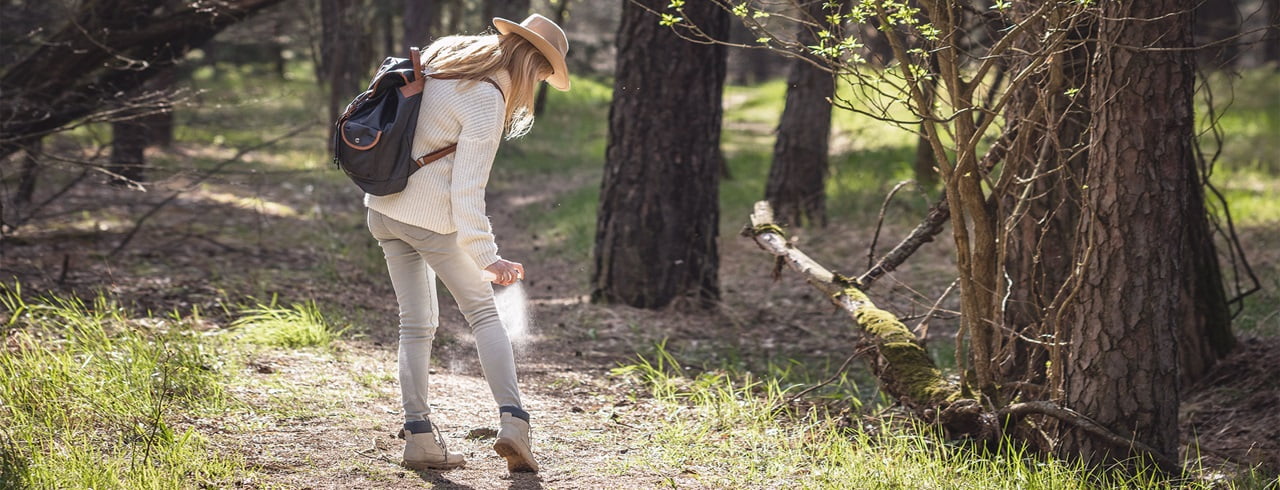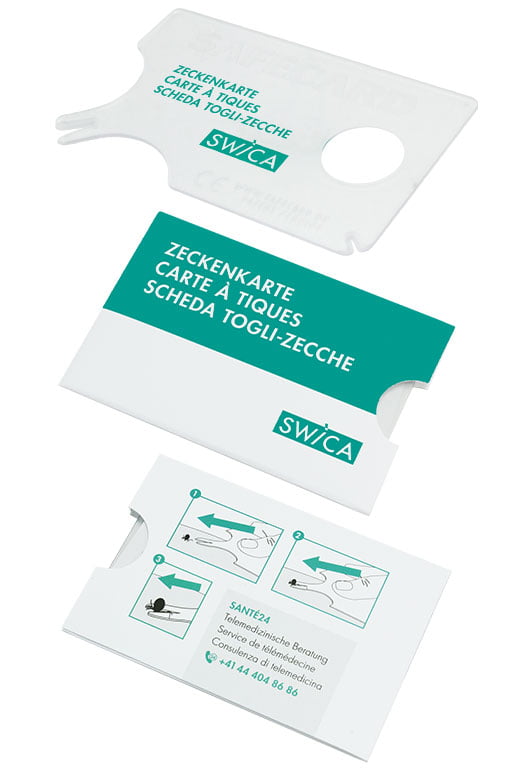
How to protect yourself against ticks
In the EU alone, 2’878 cases of tick-borne encephalitis (TBE), an inflammation of the brain, were reported in 2021, and the figure for 2020 was even higher. After Lyme disease, TBE is the most well-known disease that is dangerous and can be transmitted by ticks. During tick season, santé24 receives between 10 and 20 calls each day relating to ticks.
Find out more about ticks here, and request a free tick remover card from SWICA so that you are always able to remove ticks correctly.
Did you know? 13 fascinating facts about ticks

1. Are Lyme disease and TBE transmitted by ticks?
Ticks can transmit a large number of diseases to humans. The two most common are tick-borne encephalitis (TBE) and Lyme disease.Lyme disease is Switzerland's most common tick-borne disease. It affects around 10 000 people in Switzerland each year. The symptoms differ a lot from person to person, which can make it difficult to tell apart from other diseases. With this infectious disease, Borrelia burgdorferi bacteria from the tick's stomach take about twelve hours to infiltrate the sufferer's bloodstream. The first signs of Lyme disease can be reddening of the skin or flu-like symptoms. One characteristic symptom is a circular red rash, which occurs in more than 50% of cases. Most of the time it appears at the site of the tick bite. The rash usually forms a ring around the place where the sufferer was bitten. A Borrelia burgdorferi infection can have serious consequences if it is left untreated. If you are bitten by a tick, you should monitor the site of the bite closely and consult a doctor in the weeks that follow if you start to experience symptoms. Lyme disease can be treated using antibiotics if it is caught early.
TBE is a viral infection that affects the central nervous system. It produces almost no symptoms in 70% to 90% of cases. The symptoms of TBE first appear between seven and 14 days after being bitten, on average. Severe cases can even result in paralysis or loss of consciousness. Unfortunately there is no anti-viral treatment for TBE. There is, however, a vaccine that is recommended for all adults and children aged six and over living anywhere in Switzerland (with the exception of Ticino) or in neighbouring countries.
2. When are ticks active?
In Switzerland, tick season usually runs from March through to November. Ticks awaken from their winter dormancy and become active as soon as temperatures rise slightly above freezing. This can also happen earlier if the temperature stays above zero for a number of consecutive days in winter.3. How many different species of tick are there?
There are about 850 different species of tick worldwide, and around six of them can currently be found in Switzerland. More and more new species are making themselves at home here due to ever-increasing temperatures.The castor bean tick is the tick species most commonly encountered in Switzerland. These ticks prefer thick underbrush, woods and clearings, parks, and also gardens. The castor bean tick can grow to be up to 4.5 mm long and is the most-feared species of tick because it can carry Lyme disease and TBE.
The other tick species encountered in Switzerland are the ornate cow tick (which is a particular danger for dogs), the brown dog tick, the ornate sheep tick, the hyalomma tick and the relatively unknown Ixodes inopinatus.
4. Do ticks bite or sting?
Strictly speaking, ticks don't bite; they sting. They have a proboscis and scissor-like mouthparts. Once these parasites have found a suitable site, they slice the skin open and insert their proboscis into the tissue. They secrete saliva in order to help them suck blood better. Ticks need blood to reproduce and grow, and they can get it from wild animals and pets as well as humans.5. Where do ticks like to bite?
An empirical study carried out nation-wide in Germany analysed around 10 000 tick bites in order to get an impression of where ticks most like to bite. While ticks can bite anywhere, they prefer soft, thin areas of skin with a good blood supply. Adults were found to be more likely to get bitten in the crotch, buttocks, the insides of their upper arms and the hollows of their knees. Children frequently receive bites on their heads and necks, as well as in the hollows of their knees. You should always check your entire body for ticks after spending time outdoors.
6. What is the right way to remove ticks?
Ticks should be removed as quickly as possible after they bite in order to minimise the risk of infection. They should also be removed in one piece if possible for the same reason. Tick remover cards (or tweezers) are good for proper removal. When using a tick remover card, you should grab the tick by its mouthparts (never by its engorged body) near the surface of the skin and pull it out slowly and straight. Never twist or squash the tick. Thoroughly disinfect the site of the bite once the tick has been removed. If you don't have a tick remover card handy, another way to remove a tick is by using your fingernail. Watch the video for instructions on how to remove ticks.You should never smear the tick with oil or glue because that could cause it to start properly secreting saliva and in turn pathogens.

7. When is the best time to get vaccinated for protection against ticks?
At the moment, we only have a vaccine against TBE. While cases of TBE start to occur in spring, statistically speaking, infections peak in summer. TBE can, however, be contracted at any time in the year, including during a mild winter. While winter would be the ideal time to get vaccinated, you can do it any time of year. Three shots are required to achieve full, basic immunisation. Booster shots every ten years are then recommended.santé24's specialists offer free vaccination advice to SWICA customers. They clarify whether vaccination is recommended, and/or whether booster shots are generally worth considering.
8. Do some people attract ticks more than others?
No conclusive study has been conducted into which blood groups tend to attract ticks. A better predictor of whether people will attract ticks is what they do while they are out in nature. You are more likely to be bitten by a tick in areas of low vegetation.9. How do ticks get onto people's bodies?
Castor bean ticks are found almost anywhere with plants, such as in your garden, the woods, or the park. Ticks can't jump, and they also don't drop from trees (as is commonly thought). They can usually be found low down, between 10 and 50 cm above the ground. There, they crawl to somewhere exposed like a blade of grass or a piece of wood and wait for a person or animal to brush past them.10. How can you protect yourself against tick bites?
Wearing clothing that completely covers your body offers a certain degree of basic protection because it makes it harder for ticks to find a suitable spot on your skin. Stuffing your trousers into your socks forces ticks to make the long upwards journey, which costs them a lot of effort and also makes them more noticeable. Wearing light-coloured clothing makes it easier to find ticks. There are also many different insect repellents that keep ticks at bay and can also be applied to your clothing. You should check your entire body for ticks after spending time outdoors. This is particularly important for children who have been playing outside. You should also check pets that have been outdoors.
The general rules are:
- Wear clothing that covers your body and doesn't have any holes
- Wear light-coloured clothes
- Use insect repellent
- Check for ticks
11. What should you do after you have been bitten by a tick?
You should check the bite regularly. Taking several photographs of the site over time can help you keep track of how it changes. Do not wait to contact a doctor if you experience the typical symptoms of Lyme disease or TBE. These include a circular rash, fever, sickness, headaches or flu-like symptoms. SWICA customers who have any questions or are unsure about something can contact the doctors and medical specialists at santé24 at any time.12. When must you consult a doctor?
You should consult a doctor if you experience the typical symptoms of Lyme disease or TBE after being bitten by a tick. These can occur immediately within a few days of being bitten, or they may appear only after a few months.
They include:
- Joint pains and headaches
- A circular rash
- Flu-like symptoms
- Paralysis
- Dizziness and nausea
Please note that this list is not exhaustive.
13. Where can ticks be found in Switzerland?
Ticks can be found throughout Switzerland. Almost all species of tick pose a danger. Around 30% of tick species carry Borrelia bacteria, which can cause Lyme disease. All of Switzerland's cantons are classed as high-risk areas for TBE, although the risk is lower in Geneva and Ticino.Request a free SWICA tick remover card now

Request a free tick remover card from SWICA. The transparent card with integrated magnifying glass is the size of a credit card, which means that it fits into any wallet. Instructions in three different languages (DE/FR/IT) are included in the packaging.
How to remove a tick properly:
- Place the card against your skin
- Slide the card under the tick
- Pull the tick out slowly
- Disinfect the site thoroughly
- Circle the site using a permanent marker and write the date (in case a rash develops, and for the purpose of reporting the incident)
Order now a free tick remover card
Free vaccination advice from santé24
In Switzerland there is an increased risk of contracting TBE as a result of a tick bite. At the moment, the only vaccine available is one against TBE. Ticks can theoretically transmit TBE pathogens at any time of year. The specialists at santé24 offer professional assistance with questions relating to vaccination or ticks in general (only in German, French or Italian). Advice is free of charge to SWICA customers.
Learn more
santé24 – your Swiss telemedicine service
Phone +41 44 404 86 86

SWICA – Because health is everything
Being active pays off. SWICA – unlike many other health insurance companies – supports your personal commitment through a wide range of activities and offers relating to health promotion and preventive healthcare. Whether it's yoga, tai chi, fitness classes, swimming lessons, breathing exercises, personal training, nutritional advice, mindfulness training, tennis or one of the other available options, you enjoy attractive contributions of up to 1'300 francs* per year from the COMPLETA FORTE, COMPLETA PRAEVENTA and OPTIMA supplementary insurance plans (*see detailed information).
Incidentally, supplementary insurance always provides valuable additional benefits above and beyond those available under basic insurance. It can be taken out with SWICA at any time, regardless of which insurer currently provides your basic insurance.
Personal consultation
Would you like more information or a personal consultation? SWICA Client Services would be happy to assist. Call us on 0800 80 90 80 or send us a message using the contact form below.
Request a personal consultation



